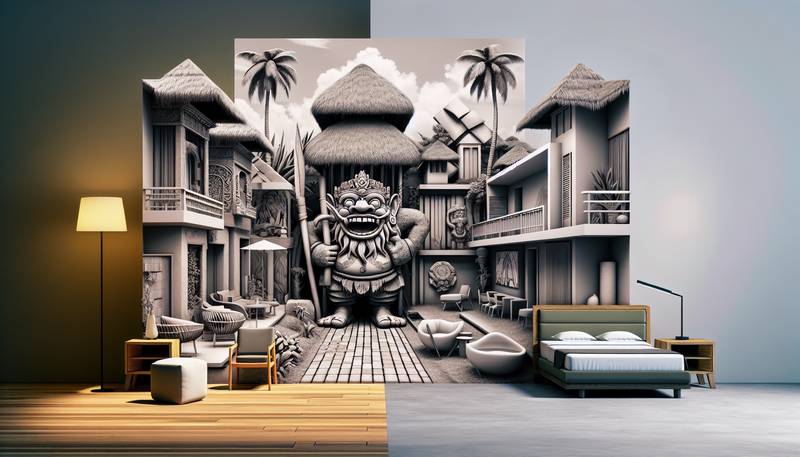Cultural Representation in Hotel Interior Design: The Good, the Bad, and the Kitsch

Setting the Scene: A Whimsical IntroductionIn the world of hospitality, the interior design of a hotel can often feel like a cheeky game of “Guess the Culture.” Walk into one establishment, and you may find yourself transported to an exaggerated version of Bali, complete with a thatched roof and a mysterious statue that’s probably just a garden gnome on vacation. Meanwhile, another hotel might declare its allegiance to modern minimalism, leaving guests wondering if they accidentally stumbled into a dentist's waiting room instead.As travelers, we hold high expectations for the spaces we occupy. We want to feel immersed, yet sometimes the quest for authenticity leads to design decisions that leave us shaking our heads while wondering whether we should laugh or cry. Cultural Representation Done RightWhen cultural representation is executed with care, hotels can truly shine as portals to different worlds. Take, for example, a boutique hotel that captures the essence of its location through thoughtful design choices. This could mean incorporating local art, traditional textiles, or architectural elements that pay homage to the region’s history. A well-designed lobby may feature local artists' works, allowing guests to appreciate the culture without needing an overpriced souvenir. In such spaces, even the furniture tells a story. A table crafted by a local artisan can provide more than just a surface for your morning coffee; it can be a conversation starter. “Is that a table made from reclaimed wood?” one might ask, while another guest nods appreciatively, mumbling something about environmental sustainability. Yes, folks, you can feel good about your choice of latte while simultaneously discussing the existential values of eco-friendly furniture.When Cultural Representation Misses the MarkNow, let’s pivot to a different side of the coin. Sometimes cultural representation in hotel design can feel akin to an awkward family reunion where your uncle insists on wearing that Hawaiian shirt—complete with neon pineapples—at every occasion. You know it’s supposed to be fun, but all you can think is, “Cousin Timmy just graduated, and this isn’t really the vibe to celebrate success.”Hotels that veer too far into kitsch can unintentionally alienate guests. Think faux cowboy hats hanging on faux-worn chairs in a themed Western hotel, where the only thing more exaggerated than the design is the cowboy’s accent. While the intention may be to provide a unique experience, when taken too far, it can feel superficial. Guests are left wondering if they should enjoy the “authenticity” or if they’re simply part of a gag reel on “Cultural Appropriation Gone Wrong.”Striking the Balance: Authenticity vs. KitschThe sweet spot lies in finding a balance between celebrating local culture and steering clear of the theatrical traps. A hotel that emphasizes authenticity can incorporate elements such as:- Locally-sourced artworks and crafts
- Architectural features that reflect historical significance
- Traditional colors and patterns that resonate with the region
However, it’s essential for designers to tread carefully. Some motifs may be popular, but they can lead to a design that feels more like a theme park than a home away from home. It’s crucial to ask: Would the locals roll their eyes or nod approvingly at these representations?The Role of Technology in Cultural RepresentationIn an ever-evolving world, technology can offer innovative solutions to cultural representation in hotel design. Think augmented reality tours that guide guests through the hotel's history, allowing them to learn about significant local traditions without pretending to be cultural anthropologists. Who needs a thick guidebook when you can swipe through a digital timeline on your phone? Picture this: guest enters their room to find a virtual assistant ready to explain the meaning behind that vibrant tapestry—oops, sorry, I meant wall hanging—as if it were a museum exhibit. “This stunning piece showcases local craftsmanship, but don’t touch, or the art police will be summoned!” Wrap Up with a Dash of WitAs the curtains close on this exploration of cultural representation in hotel interior design, it’s clear that balance is key. Strive for authenticity without slipping down the rabbit hole of kitsch, and your hotel will not just be a place to stay—it'll be a memorable experience. Remember, creating a hotel space that resonates with culture is like crafting a beautiful dish: no one wants too much salt, but a sprinkle of something special can elevate the entire experience. So next time you check into a hotel, keep your eyes peeled—because you might just find yourself in a beautifully designed love letter to the local culture, or, well, a cheeky postcard with a questionable sense of humor.
|
|







